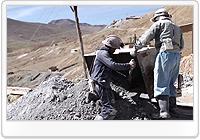Young Bolivians work for one of "world's most dangerous mines"
Published by MAC on 2011-06-28Source: UNICEF
This year's World Day Against Child Labour, marked on 12 June, is focusing on hazardous working conditions faced by some 115 million children worldwide.
What follows is an account of what life's like for a 13-year old boy who has worked at one of Bolivia's biggest silver mines since he was nine years old.
A joint study by UNICEF, the National Institute of Statistics and the International Labour Organization in 2005 found there were approximately 7,000 children working in gold and silver mines in Bolivia's Potosí, Oruro and La Paz districts.
Young Bolivians on working in one of the world's most dangerous mines
By Thomas Nybo
UNICEF
11 June 2011
POTOSÍ, Bolivia - Thirteen-year-old Agustin Leandro's life revolves around mining. He lives in a shack right outside the entrance to a mine shaft at the famous Cerro Rico mine in the city of Potosí, where he worked two hard years digging for ore from the age of nine.
 |
| Santiago Leandro, 15, shovels out what he's gathered in the treacherous mines of Potosí, Bolivia. Source: UNICEF |
Back then, the older miners would only pay him the equivalent of $3 per day, so he quit and now leads tours of the mine instead.
Cerro Rico, which means 'rich mountain', has been called one of the most dangerous mines in the world. It's been in operation for more than 400 years, and once held the richest supply of silver in the Americas.
"There aren't too many children working here - it's too dangerous," Agustin says. "To get the minerals here, you need to go deep into the mine. Most kids work in mines that are less deep and easier."
A joint study by UNICEF, the National Institute of Statistics and the International Labour Organization in 2005 found there were approximately 7,000 children working in gold and silver mines in the Bolivian cities of Potosí, Oruro and La Paz.
The Bolivian Ministry of Labour has since categorized mining as one of the worst forms of child labour, due to its impact on children's health and access to education. Reducing child labour is integral to achieving the Millennium Development Goals of poverty reduction, education, HIV/AIDS and gender equality.
Hazardous conditions
Inside the mine, it's claustrophobic and the air is thin. When he gives tours, Agustin hands out a head lamp and plastic helmet to each group member, before leading them into the darkness.
On his tours, Agustin stops at a shrine, where miners ask a deity named ‘Uncle Jorge' for protection from accidents. They also leave gifts of cigarettes and alcohol, hoping ‘Uncle Jorge' will respond by leading them straight to the richest minerals in the mountain.
One of the children who works in the mine is Agustin's 15-year-old brother, Santiago. He uses his small body to reach places too tight for older miners. He breaks up the rock and then pushes the ore through a gap to an older miner waiting in the main mineshaft below with a rail cart.
Once the rail cart is full, they will push and pull it back through the narrow tunnel leading to the outside world. Santiago will then shovel out the content of the cart, to be picked up by a truck. It is part of a tough cycle he will repeat throughout the day. The work is unrelenting.
Santiago and Agustin live in a shack right next to the mine entrance, along with their sisters and sometimes their mother, who frequently leaves to tend crops on a distant farm. Nobody attends school. Like many long-term miners here, their father died from lung disease. Those who have lived and worked near the mine for years say the life expectancy of a miner here is about 40 years.
Combating causes of child labour
Poverty and family disintegration are two of the most common causes for children working in mines, says UNICEF Child Protection Officer in Bolivia Sandra Arellano. The Bolivian government, with UNICEF support has recently announced new measures to protect children from exploitative labour.
"A bonus is being provided for children who regularly attend school. This is a contribution to the families' incomes in order to cover the cost of educational materials, which indirectly prevents child labour," she explains.
Even so, Agustin can't imagine a future without the mine - it's the source of income he knows best. "Some years, there have been a lot of tourists, so we can make money. In one day, we might run two or three tours."
He adds: "If you're a doctor, patients can make you sick. And teachers - there are all sorts of rules holding them back. But as guides, no one tells you what to do. All you need to know is English."
For Agustin and Santiago, life at the mine is still the face of opportunity for now. As the afternoon wears on, Santiago hears its call, and pushes the metal cart back into the mine, one more time.